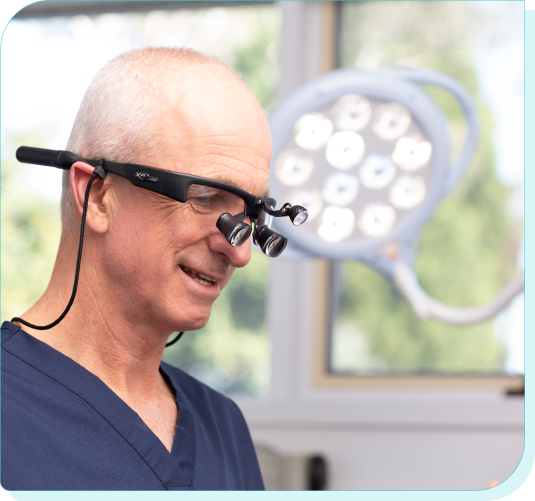
Luckily, preparing for your vasectomy is quick and easy. At home on the morning of the procedure, please shave the underside of the penis and all of the front and sides of the scrotum to give clear access to the site. To make it easier you can trim first with hair clippers (always use a No.1 or 2 guard to prevent catching the skin). We suggest that you don’t use depilatory creams such as Veet and Nair as these can cause chemical burns. Waxing works well but can be painful.
Ring our office to confirm your attendance 48 hours before the procedure.
Tell us:
If you are taking any blood thinning medication (Iscover/Co-Plavix, Pradaxa, Xarelto, Eliquis, Brilinta or Warfarin) or have a bleeding disorder. Please let us know at time of booking and ask for more information and instructions.
Aspirin, ginkgo, olive leaf extract can continue to be taken.
NOTE:


The procedure is simple, seamless, virtually pain-free and over in
10-15 min – and patients can drive themselves home!
We apply local anaesthetic to the vasa using a fine needle, with no injections into the testes. We make a single opening 2-4mm in size which will close rapidly and heal without the need of stitches using our signature ‘no scalpel’ microKeyhole™ method.
If you have any questions, please contact our team directly to discuss your concerns with a consultation.
Vasectomy Definition:
Vasectomy is the name given to the operation which makes men infertile by producing a block to sperm movement from the testes and is the safest and most efficient form of permanent contraception currently available. Immature sperm are produced in both testes (testicles) and travel up in a tube called the vas deferens(plural=vasa) on each side to a sponge-like storage area near the seminal vesicle at the back of the bladder where they are stored and mature prior to release.
The recovery process post procedure is straightforward and seamless.

Pain Management
There is usually little post vasectomy pain but the amount does vary unpredictably ranging from none to significant pain and swelling in rare instances. Pain can start from 1 hour after the operation (when the local anaesthetic starts wears off) or even start a few days or weeks later. It is usually due to inflammation of the epididymis and not infection. If significant pain or swelling occurs try to rest and take ibuprofen (an anti-inflammatory) 200mg, 2 tablets 3-4 times a day after food on a regular basis. Add paracetamol 500mg, 2 tablets 3-4 times a day if the ibuprofen alone is not helping.
Increasing pain or swelling, redness or fever is not usual, and you should contact us on 1300 377 647 or see your local doctor or attend an emergency department.
Bruising
Bruising of the skin on the scrotum is common, not a concern and will disappear with time.
Bleeding
In the rare case that the wound bleeds, ‘pinch’ over the wound with some gauze or a tissue for ten minutes, then let go very slowly.
Washing
Shower as normal but do not have a bath or go swimming for 2-3 days until the wound heals.
Wound Care/Support
It is advisable to continue to wear supportive underwear for 2-3 days (place a piece of gauze or tissue over the wound until healed).
Activity and sex
Take it easy for 2-3 days, after which your level of activity including sex should be guided by your degree of comfort. Strenuous activities (running, bike riding, prolonged walking, climbing and repetitive lifting) should be avoided for the first week if possible. Excess activity may cause increased pain but will not cause any permanent ‘damage’.
Sterility
You are not sterile yet! Sterility takes approximately 8-12 weeks after a vasectomy to occur. At the 12-week mark, most patients are ‘all-clear’, and no repeat tests are needed. Your operation cannot be considered successful until you have confirmed with us that you are all clear.
Instructions for Collecting a Semen Sample for the 12-week test
You will be given a pathology request slip, instruction sheet, specimen sheet and a bag at your first visit. At 12 weeks, you will get a semen sample following the directions provided. Screw the cap onto the jar firmly and label the jar with your name, time of collection and date. Drop the specimen off at a collection point listed on the referral and the test is normally bulk billed. You may take your sample to another pathology provider but please be aware that there may be out of pocket costs.
Please call us on 1300 377 647 three days later for the result. We will either confirm that you are ‘all clear’ or arrange a repeat test.
A vasectomy is a highly effective form of permanent contraception for men. It’s a quick, minimally invasive procedure to block sperm from exiting the testes, so that ejaculate no longer contains sperm and cannot impregnate a sexual partner.
Whilst a vasectomy is the safest form of permanent contraception, you will not be sterile immediately; for most it takes a minimum of 2-6 weeks for the sperm stored in the seminal vesicle (which is above the site of the vasectomy) to be cleared from the system. After 12 weeks a sperm count is performed which involves taking a specimen of your semen to a pathology centre where it will be sent away to be examined for the presence of sperm. When no sperm are found, sterility has been achieved. One in 10 patients still have sperm present and repeat tests are performed monthly until none are left, 99% are clear by 6 months. The overall failure rate of our operation is about 1 in 1000 compared with 1 in 300 for the traditional method and in women who have tubal ligation. This includes failure to identify and deal with the vasa, an extra vas and early or late spontaneous re-joining of the ends with re-canalisation. Once it has been established that the semen is clear of sperm subsequent failure of the procedure, due to the spontaneous re-joining of one or both vasa is very rare, occurring only in about 1 in 5,000 vasectomies.
Most men experience little or no pain however a few experience discomforts, bruising and swelling of a minor and transient nature. This is usually relieved by rest, simple pain medications and supportive underwear. Serious side effects are extremely rare.
Complications may occur and include long-term pain and tenderness(2%), sperm granuloma, infection, inflammation of the epididymis and testes, scrotal haematoma (blood clot), bleeding, cyst formation, development of anti-sperm antibodies, delayed wound healing and adverse reactions to the skin preparation, latex gloves, local anaesthetic and heat cautery/diathermy. Very rarely injury to an artery may result in loss of a testicle due to impaired blood flow.
If you are considering this question, we recommend discussing if a vasectomy is the right choice for you with a doctor. A Dr Snip vasectomy should be considered irreversible however there are 2 methods which may overcome the effects of a vasectomy should circumstances change. The first method is microsurgical reversal operation. The functional success rate for this operation is quite high (up to 90% in the first 5 years following vasectomy) but declines with time due to decreased sperm production and the development of anti-sperm antibodies. An alternative method to reversal for future pregnancy is an ‘IVF’ procedure known as ICSI (intracytoplasmic sperm injection) which involves injecting into an egg either a mature sperm from semen stored before the vasectomy or an immature sperm obtained by way of needle biopsy from the testes. Sperm storage obviously requires pre-planning with storage of sperm prior to the procedure.
Note: Medicare does not rebate reversal operations, or ICSI or sperm storage.
A vasectomy will have no physical effect on your sex drive, erections, or performance as these are all driven by testosterone production. Your body produces the same amounts of testosterone after a vasectomy. Ejaculations also remain the same as most of the semen is produced away from the testes and the vasectomy site. In fact, many men say their sex life improves because they are no longer worried about unintended pregnancies.
Whilst we do everything, we can to reduce the rate of complications, all surgical procedures have risks that you should be aware of. A full list of potential complications is outlined in the patient consent form.
After your vasectomy, most men will notice some level of:
Rare potential complications include:
At Dr Snip, we have pioneered the modern vasectomy and a laser is not required as it provides no additional benefit. We use state of the art technology to ensure ease, comfort and results for all of our clientele.
Please directly contact Dr Snip or book online here
To see the latest cost: see our Costs page here.
Put simply, a vasectomy redirects the flow of sperm.
Before a vasectomy, sperm are produced in the testes/testicles and travel via tubes called the vasa deferentia (plural for vas deferens) to the penis. Semen, the fluid expressed from the penis during ejaculation, carries these sperm.
After a vasectomy, sperm no longer travels to the penis and cannot exit the body in semen during ejaculation. The sperm in your semen will gradually deplete until there are none – at which point you will be sterile.
Because semen is produced in the prostate gland, seminal vesicles and Cowper’s gland — and not the testicles – you will still produce semen and ejaculate as normal. It will look very much the same, only it will no longer contain sperm, meaning you can have sex without the risk of pregnancy.
A good analogy: imagine a puddle with tadpoles compared with one without!
Recovery from a vasectomy is self-directed. That means you can resume having sex as soon as you’re comfortable doing so! This is generally between two and seven days after the procedure.
Before your vasectomy, your doctor will use a fine needle to apply anaesthetic to the vasa deferentia, which are the two tubes that carry sperm from each teste to the penis. No needle will enter your testes at any point.
Your doctor will then create a single micro-keyhole opening (no more than 4mm) in the centre of your scrotum, below the penis. The Dr. Snip technique does not use scalpels for a minimally invasive procedure. After your vasectomy, this opening will close rapidly and heal on its own without stitches.
Once your doctor has located the vasa, they gently draw out each vas through the same opening, one at a time. For each vas, the doctor will make a small incision and seal the end of the tube that goes to the prostate (mucosal cautery).
Your doctor will either cover that end of the vas with tissue (fascial interposition) or seal it with a tiny titanium clip or dissolving thread to prevent the two disconnected ends of the vas from rejoining.
At Dr. Snip, we perform open-ended vasectomies. That means the other end of the vas, which connects to the testicle, is left open and unsealed to minimise discomfort during recovery.
We opt for the open-ended technique because it ensures best outcomes for you: fewer complications, minimal disruptions and a very low failure rate are associated with this vasectomy.
Traditional vasectomies, typically performed under general anaesthetic, involve cutting into the skin and disrupting blood vessels to access the vasa, which increases the risk of failure and complications.
The Dr. Snip method is swift and straightforward, usually taking just six to ten minutes.
A vasectomy redirects sperm on its journey from the testes to the penis, so that semen will no longer contain sperm or be able to cause pregnancy.
Like sperm, the male hormone testosterone is also produced in the testes, but testosterone is absorbed into the bloodstream directly. This means a vasectomy does not affect your hormone levels, and your sex drive and libido will remain the same.
A Dr. Snip vasectomy is quick, easy, non-hormonal, and the most effective form of permanent contraception available to men.
At Dr. Snip, we perform ‘open-ended’ vasectomies, meaning the tube from the teste that we ‘snip’ (the vas deferens) is not resealed. So, sperm that would usually travel from the testes to the penis via this tube is redirected into the scrotum, where the body reabsorbs it.
Over time, this open end will seal itself and your body will stop actively producing sperm. Although this process can be reversed in a separate procedure, a vasectomy should be treated as a permanent contraceptive solution.
The vasectomy procedure is very simple and usually takes 10-15 minutes.
Your semen colour will remain the same after your vasectomy, varying between white and yellow.
Complete an enquiry form online or phone our friendly team on 1300 377 647 (1300 DR SNIP) to book your vasectomy with Dr. Snip.
We invite you to attend your pre-vasectomy consultation and receive the snip on the same day for your convenience.
Alternatively, you can arrange a standalone pre-vasectomy consultation to discuss the procedure in more detail before you book your vasectomy appointment.
At your first visit, you will receive a pathology request slip, bag, instruction and a specimen sheet.
12 weeks after the procedure, you will need to provide a semen sample by following the directions provided. Please ensure the cap is firmly secured, the jar is labelled with your name, time of collection, and date. Drop the sample off at a collection point listed on the referral. Other pathology providers will generally accept the referral, but in some locations, they may not provide this specific test.
Please be aware that fees for this test will vary by provider and location. Please call us on 1300 377 647 three days later for the result. We will either confirm that you are ‘all clear’ or arrange a repeat test.
Please call us on 1300 377 647 or send us an online enquiry and one of our friendly staff will reply promptly.
